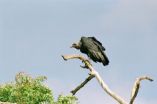Godwin Atser
g.atser@cgiar.org
234-803-443-0027
CGIAR
Scientists arrive in Senegal to give African hunger a black eye
At the World Cowpea Research Conference, crop experts embrace one of agriculture's oldest legumes -- prized for protein and resilience to hot, dry climates -- as food for people, livestock and astronauts
This release is available in French.
DAKAR, SENEGAL (27 September 2010)—A long neglected crop with the potential to halt hunger for millions in Africa, sustain the livestock revolution underway in developing countries, rejuvenate nutrient-sapped soils, and even feed astronauts on extended space missions, is attracting scientists from around the world to Senegal this week for the Fifth World Cowpea Research Conference.
"It's hard to imagine a more perfect crop, particularly for Africa, where food production lags behind population growth, demand for livestock products is soaring, and climate change is bringing new stresses to already challenging growing conditions," said Christian Fatokun, a cowpea breeder at the International Institute of Tropical Agriculture (IITA), which is co-organizing the conference in collaboration with Institut Senegalais de Recherches Agricoles (ISRA), Dry Grain Pulses Collaborative Research Support Program, and Purdue University.
"But fulfilling the promise of this marvelous legume requires intensive efforts to deal with threats that inhibit production and long-term storage," he added. "The good news in Senegal is that researchers will be revealing new and innovative approaches to dealing with the pests and weeds that attack cowpeas at every stage of their lifecycle and with the voracious weevils that devour dried cowpeas."
The cowpea, which is also known as the black-eyed pea, is one of the world's oldest crops. It is currently cultivated on 10 million hectares, mainly in Central and West Africa, but also in India, Australia, North America, and parts of Europe. It was brought to the Americas on slave ships and became a favorite of President George Washington, who was looking for a variety of peas—he called them "pease"—that could withstand the warm climates of the southern United States. Cowpeas are treasured for their high protein content (grains contain about 25 percent protein), leaves and stalks that serve as especially nutritious fodder for cows (hence the name cowpea) and other farm animals, and the fact that their roots provide nitrogen to depleted soils. For many in Africa, the crop is a critical source of food during the "lean period"–-the end of the wet season when food can become extremely scarce in semi-arid regions of sub-Saharan Africa.
The many qualities of the cowpea are being discovered anew for a number of reasons. One is the potential of the cowpea's high protein content to help satisfy dietary requirements in food-challenged developing countries, particularly in Africa, where over 200 million people remain undernourished.
Cowpeas provide strong yields, even in hot and dry conditions, and scientists are developing ever more resilient varieties. And as climate change turns up the heat in sub-Saharan Africa, there is growing concern that production of current staples such as maize and rice will fall or even collapse in some areas, requiring so-called "climate-ready crops" like cowpeas to fill the void.
In addition, cowpeas can be used as cheap, high-quality animal feed. Today, livestock experts are drawn to the cowpea as they search for sustainable approaches to satisfying the fast-growing demand for meat and milk in developing countries. Scientists at IITA and the International Livestock Research Institute (ILRI) say new "dual use" cowpea varieties bred to satisfy both human and animal nutrition needs could be generating US$299 million to US$1.1 billion by 2020, given their potential to simultaneously boost livestock production and reduce hunger.
The cowpea is also well-known for its ability to infuse soils with nitrogen, which again makes it a crop that could be enormously valuable to Africa, where many farmers struggle with nutrient-poor soils that are among the most challenging in the world.
Even the National Aeronautics and Space Administration (NASA) is on the cowpea bandwagon. With the plant's ability to produce nutritious leaves in only about 20 days, NASA scientists are considering sending cowpeas to the international space station, where they could be cultivated to provide food for astronauts.
This widely ranging and rapidly intensifying interest will be highlighted at the World Cowpea Conference, where ground-breaking work in all aspects of cowpea production would be showcased.
For example, new research to be presented at the conference from researchers at IITA and the University of California-Riverside focuses on the successful use of cutting-edge genome analysis tools and techniques to probe cowpea DNA for genetic traits associated with prized qualities like drought and disease resistance.
"When we can zero in on a particular place in the genome and essentially point to the DNA that is providing the traits we want, the time it takes to breed improved cowpea varieties can be shortened from a decade or more to three years or less," said Fatokun, who specializes in cowpea genomics.
Scientists also will report on the latest developments in efforts to use biotechnology to borrow a gene from a soil bacteria, bacillus thuringiensis or Bt, to create a transgenic cowpea variety. The goal is to provide farmers with cowpeas that can fend off assaults from a caterpillar known as the Maruca or bean pod borer that routinely ruins entire fields. Researchers also will discuss endowing cowpea varieties with a gene from a common bean plant to provide protection infestations during storage.
Related discussions will focus on fresh research probing the risk of transgenic Bt cowpea spontaneously mating or "crossing" with wild relatives—wild cowpea is common in West Africa, which is a "center or origin" for the crop—and possibly creating a super weed that would be difficult to control.
Sacking the Cowpea Beetle
One reason cowpeas are not as widely cultivated as corn or rice is that storage of dried peas is complicated by a tiny reddish-brown beetle, the cowpea weevil, that rapidly reproduces in traditional grain sacks and renders the food inedible.
In Senegal, scientists from Purdue University in the United States and Niger's Institute of National Agriculture Research will report on an effort to disseminate a simple storage technology to African farmers, which comprises a three-layer plastic bag that shuts off the oxygen required to fuel a weevil population explosion.
Frittering Away to Financial Success and Animating Seed Distribution
Other research to be discussed at the conference focuses on the challenges of translating cowpea production into income and how to encourage wider adoption of improved cowpea varieties along with better approaches to cultivation and storage.
For example, researchers will discuss a new study analyzing the economic fortunes of hundreds of street vendors in Ghana and Niger who sell a popular, deep-fat fried fritter made from cowpea batter called kossai or akara. Most of the vendors are women, and the researchers found that they tend to earn 4 to 16 times more than the prevailing minimum wage in their countries.
Meanwhile, in another study, researchers will discuss an innovative effort that brings together scientists, linguists, and 3-D animators to provide cowpea educational materials and training programs for rural farmers.
###
Editor's Note: For live updates from the World Cowpea Research Conference, visit IITA's blog at http://iitanews.blogspot.com/ About the World Cowpea Research Conference
The World Cowpea Research Conference is a gathering of international experts that, through sharing and exchanging of knowledge and ideas, aims to identify opportunities for cowpea growers to gain more incomes, enhance food security, and attain robust health. The event is also targeted at increasing the public's awareness and appreciation of cowpea, hopefully leading to more support for the cowpea scientific community to enable researchers to carry out cutting-edge research and help realize the crop's potential. The conference is organized by IITA in cooperation the Institut Senegalais de Recherches Agricoles (ISRA), the Dry Grain Pulses Collaborative Research Support Programme (Pulse-CRSP), and Purdue University.
About IITA (www.iita.org)
Africa has complex problems that plague agriculture and people's lives. We develop agricultural solutions with our partners to tackle hunger and poverty. Our award winning research for development (R4D) is based on focused, authoritative thinking anchored on the development needs of sub-Saharan Africa. We work with partners in Africa and beyond to reduce producer and consumer risks, enhance crop quality and productivity, and generate wealth from agriculture. IITA is an international non-profit R4D organization since 1967, governed by a Board of Trustees, and supported primarily by the CGIAR.


